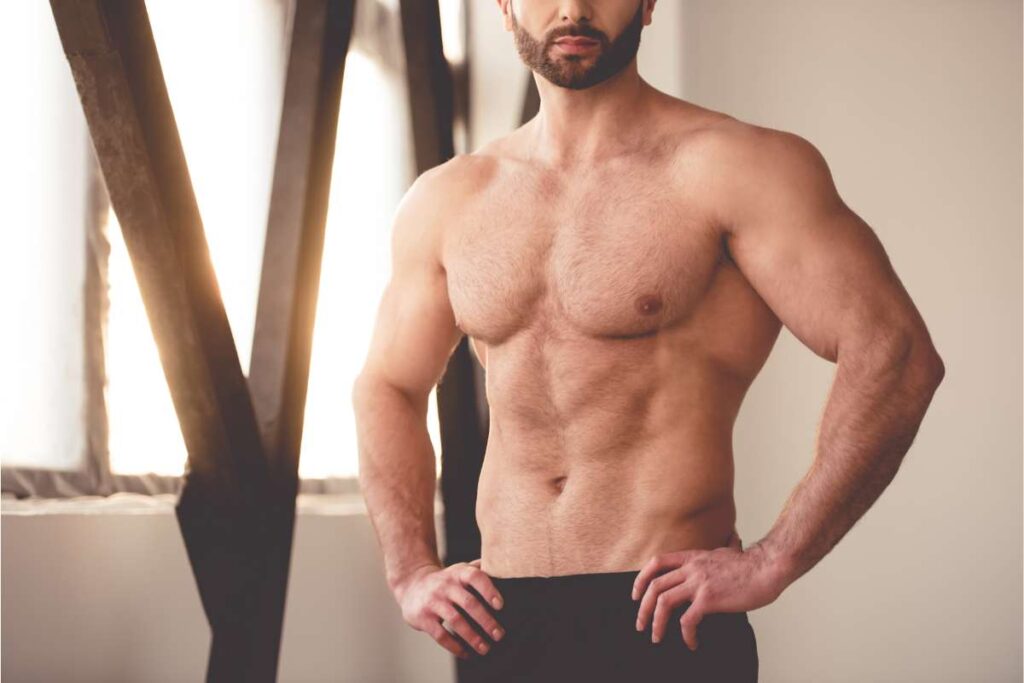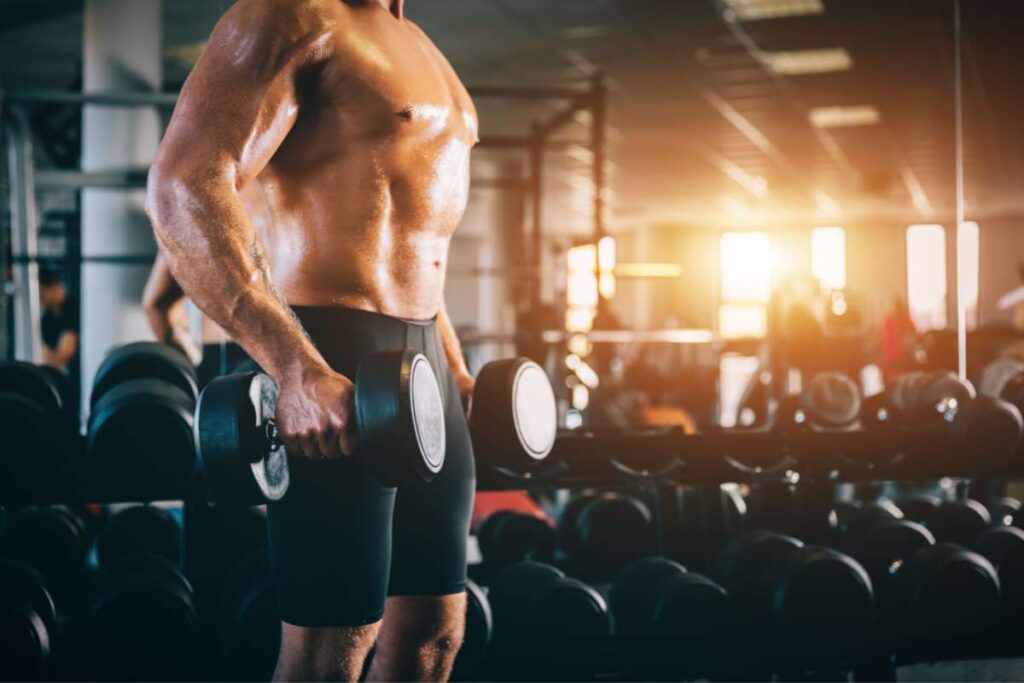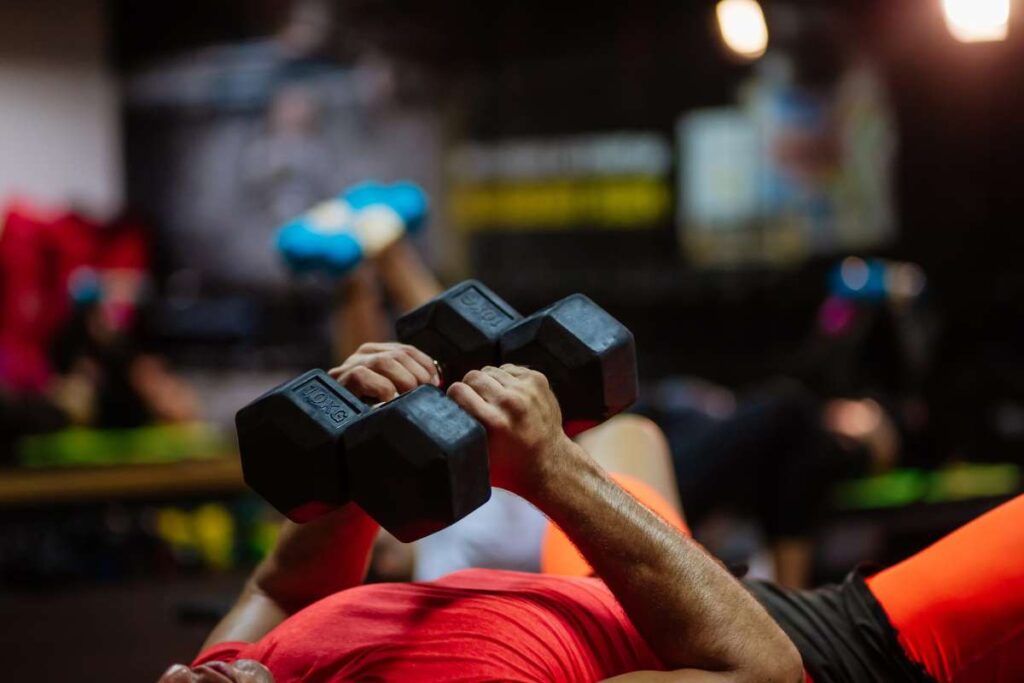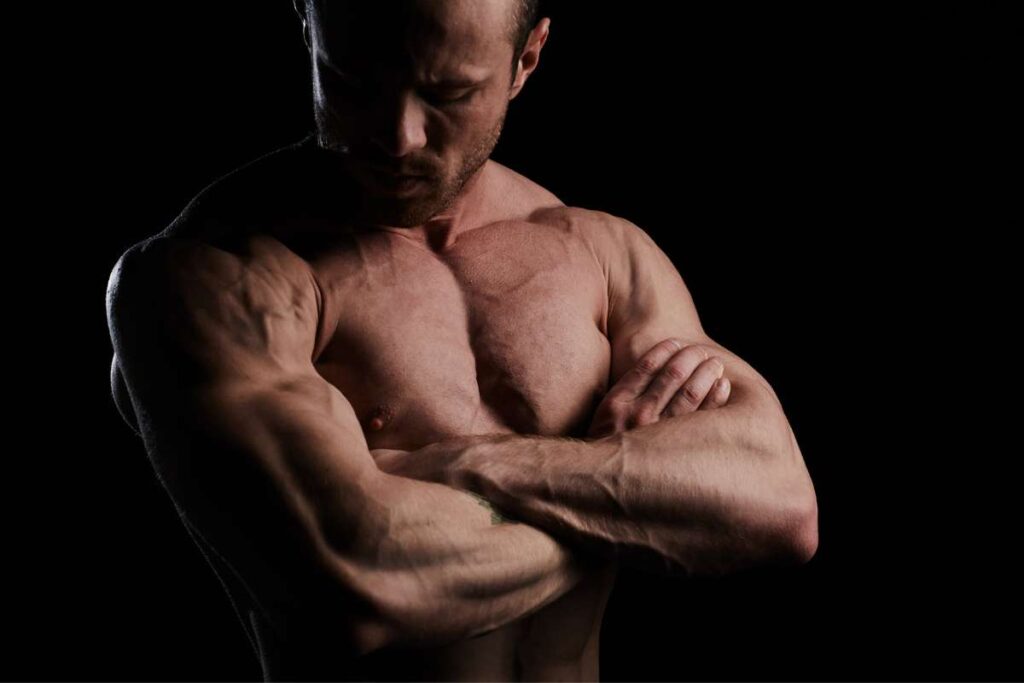This post may contain affiliate links at no additional cost to you. As an Amazon Associate I earn from qualifying purchases. Click to view our full disclosure.
What's inside
Welcome to my guide to performing a dumbbell chest workout without a bench.
If you’re working out at home, you may be wondering how to train your chest with more than just push-ups.
After all, as the rest of your training progresses, the lack of additional resistance for your chest will start to show.
Naturally, not everyone has the space and budget to add a bench to their home gym.
Don’t worry – you don’t need one. Helping people get impressive results – even without big, expensive pieces of gym equipment – is something that I’ve helped many clients with over the past decade as a personal trainer.
Today, I’ll discuss the top 10 exercises and a full chest workout without a bench, so you can get started sculpting a massive chest at home.
We’ll also go over your chest anatomy and the benefits of these exercises, with plenty of professional tips along the way.
Let’s jump in.
Chest Muscle Groups
Related: What Are Bad Chest Genetics And How To Fix Them

To start, here’s a list of chest muscles and functions to help you target specific parts of the chest during your workouts.
| Muscle | Function |
| Pectoralis Major | Horizontally Adducts Shoulder, Adduction, Internal Rotation |
| Pectoralis Minor | Protraction, Abduction, Internal Rotation, Stabilization |
Benefits of a Dumbbell Chest Workout
Related: Why Do I Have One Arm Bigger Than The Other?
Dumbbells are a brilliant piece of equipment that can add variety to our training.
Here are some of the best benefits of dumbbell chest workouts.
Wide Range of Motion
Dumbbells offer a wider and greater range of motion than barbells.
When you perform a press with a barbell or in a push-up, the spacing of your hands is fixed into position and doesn’t allow you to lower past the chest.
Dumbbells, on the other hand, allow the hands to move independently.
Less Stress On Joints
Dumbbells are great for reducing restriction and stress on our joints.
This is due to each hand’s ability to move independently, which is better for shoulders, wrists, and elbows.
This way, you can position a dumbbell and guide it through an entire range of motion that suits your joints.
Promote Muscle Hypertrophy
Dumbbells are excellent for promoting muscle hypertrophy.
Research indicates that by performing sets of 8-12 repetitions at 60%-80% of your one repetition max (1RM) is required to build lean muscle mass.
Dumbbells are the ideal tool for working within this reps range. They provide us with the resistance required to stimulate our muscle tissue with the added benefit of being able to lower them to the floor should we fail during our lifts.
This is great for when we want to push ourselves to our limit for those gains.
Improves Physique
Dumbbells are brilliant for improving our physique as they provide a freedom over movement that helps us target direct fibers of our chest.
This, combined with training for hypertrophy, will help us target underdeveloped areas of our body, helping us fill out our physique.
Increases Shoulder Stability
You should use dumbbells to improve shoulder stability.
They require a greater degree of balance and control when we’re performing pressing movements, which engages the stabilizers of the shoulder.
This keeps our rotator cuffs and deltoids in good health, improving function and reducing the occurrence of injury.
Related 10 Best Chest Exercises For Women: Beginner And Advanced
Can I build my chest without a bench?

Yes, you can build your chest without a bench providing that you progressively overload by using dumbbells, kettlebell, bodyweight exercises, and bands.
How can I do dumbbell chest workouts without a bench?
Related: 10 Best Exercises To Include In Your Push Day Workout Program
You can do dumbbell chest work without a bench by lying on the floor or positioning them beneath your hands during a push-up.
While there is a smaller range of motion with certain exercises, there are many variations that will allow you to target and build a bigger chest.
10 Best Dumbbell Chest Exercises Without a Bench

Training the chest without a bench requires a little bit of creativity, but with the right exercise, it can really improve your physique.
Here are the 10 best dumbbell chest exercises you can do without a bench to grow a strong chest.
1. Dumbbell Floor Press
The dumbbell floor press is a great exercise for targeting the chest.
Lying on the floor adds stability and allows you to push a heavy resistance without fear of dropping weight all the way to the floor.
Equipment
- Dumbbells
How To Perform the Dumbbell Floor Press
- Sit down on the floor, holding a dumbbell in each hand.
- Lie back, and press up directly over your chest, with arms straight.
- Place feet on the floor with knees bent at 90 degrees.
- Begin by bending the elbows and lowering the dumbbells down toward your chest.
- Lower until your triceps make contact with the floor.
- Once they reach the bottom, press them back up to the starting position. Repeat.
Benefits
- Can be done without a bench.
- If you fail, you can easily lower dumbbells to the floor.
Pro Tips
- When you lie back on the floor, firmly plant your feet on the ground. This will help you stabilize your body for the press.
- Focus on your breathing with each repetition and tense your core muscles. This will improve stability.
2. Dumbbell Floor Fly
The lying dumbbell fly helps you perform the dumbbell fly with a heavier weight and a shorter resistance.
This floor limits the range of motion, which can decrease the chance of injury.
Equipment
- Dumbbells
How To Perform the Dumbbell Floor Fly
- Sitting on the floor, pick up a dumbbell in each hand.
- Lie onto your back and press the dumbbells directly up over your chest with a neutral grip.
- Position feet flat on the floor, shoulder-width apart.
- Begin by bending your elbows out to the side and lower the dumbbells down toward your chest.
- Lower until your upper arm makes contact with the floor.
- Once you reach this position, pull the dumbbells back up over your chest. Repeat.
Benefits
- Safer for shoulders as it limits how far you can lower dumbbells.
- Can load up the weight to really overload the chest.
Pro Tips
- Start with a lighter weight and familiarize yourself with the range of motion.
- If you want to load up the weight, consider keeping the elbows bent between 70-90 degrees. This is a stronger position and will help you perform the fly at a much heavier weight.
3. Dumbbell Push-Up
Dumbbell push-ups use dumbbells as handles during the push-up.
This is great for those who struggle with wrist mobility. It allows you to lower yourself into a deficit, where the chest goes lower than the hands.
Equipment
- Dumbbells
How To Perform the Dumbbell Push-Up
- Holding a dumbbell in each hand, set yourself up in the push-up position.
- Place weight on the balls of your feet while your upper body weight is supported by the dumbbells in your hands.
- Start by bending your elbows and lowering yourself down toward the floor.
- Lower until your elbows are bent at 90 degrees.
- Once at the bottom, push yourself back up to the beginning position. Repeat.
Benefits
- Great for people who struggle with poor wrist mobility.
- Increase muscle mass.
Pro Tips
- Keep your hips parallel with the floor for the duration of the set. This will help target the glutes and abs as well as provide stability for the exercise.
- Focus on breathing, inhaling as you lower and exhaling as you press. This will help with core engagement.
4. Dumbbell Push-Up Fly
The dumbbell push-up fly targets the chest and requires a huge degree of control, which is great for targeting the abs.
Equipment
- Dumbbells (round)
How To Perform the Dumbbell Push-Up Fly
- Holding a pair of dumbbells, assume the push-up position.
- Place feet shoulder-width apart with the weight resting on the balls of your feet.
- Hold the dumbbells in a neutral grip shoulder-width apart to support the upper body.
- Start by rolling the dumbbells out to the sides, allowing your elbows to bend.
- Lower until your elbows are bent at 90 degrees.
- Then, pull the dumbbell back to the midline of the body and push yourself back up. Repeat.
Benefits
- Requires full-body engagement.
- Increases muscle mass.
Pro Tips
- This exercise should be performed with round dumbbells so they can roll during the fly.
- Beginners should start with a wider stance and gradually test range of motion, as coming back up from a greater depth can be challenging even for advanced lifters.
5. Dumbbell Eccentric Floor Flys
Dumbbell eccentric floor flys allow you to load up your flys and slowly lower them to the floor before pushing them back up with a press.
This helps you overload the fly, while the press is an easier movement that will still provide a challenge.
Equipment
- Dumbbells
How To Perform Dumbbell Eccentric Floor Flys
- Sit on the floor and grab a dumbbell in each hand.
- Lie down and press the dumbbells up, positioning them over the chest.
- Rotate the dumbbells so they are in a neutral grip.
- Begin by bending your elbows and lowering the dumbbells out toward the side.
- Lower until your elbow is bent at 90 degrees.
- Rotate the dumbbell into a pronated position and press them back up to the starting position. Repeat.
Benefits
- Eccentrically loads the fly movement.
- Floor stops you from lowering the dumbbells into a deficit, which can put a strain on the shoulders.
Pro Tips
- Beginners should start with a lighter weight and focus on technique.
- When selecting a weight, aim to find one that is just too heavy to fly, but easy to press. This will help you eccentrically load the chest, while giving you the security of being able to press the dumbbells back up to complete the movement.
6. Dumbbell Alternating Floor Press
The dumbbell alternating floor press targets the chest and adds an element of instability as you need to control one dumbbell at a time.
This is great for core control and shoulder stability.
Equipment
- Dumbbells
How To Perform the Dumbbell Alternating Floor Press
- Grab a dumbbell in each hand and sit down on the floor.
- Lie back and immediately press the dumbbells up so they are over your chest.
- Start by bending one elbow and lowering the dumbbell down to your chest, while the other remains still.
- Lower until elbows are bent at 90 degrees.
- Once at the bottom, press the dumbbell back up to the starting position. Alternate for the remaining reps. Repeat.
Benefits
- Increase muscle mass.
- Requires stability and control of the core and shoulders.
Pro Tips
- To get the most out of the movement, focus on breathing and tense the abdominals. This will help keep your body stable for the entire set.
- If you want to increase the challenge, unhinge the elbow of the stationary arm. This will make the muscles of the shoulder and arm work harder.
7. Dumbbell Close Grip Floor Press
The dumbbell close grip floor press is designed to target the chest, shoulders, and triceps.
It is a simple and effective movement to add variety to your routine.
Equipment
- Dumbbells
How To Perform the Dumbbell Close Grip Floor Press
- Sit down on the floor holding a dumbbell in each hand.
- Lie back on the floor and press the dumbbells straight up over the chest.
- Rotate the dumbbells so they are in a neutral grip position.
- Place feet shoulder-width apart with your knees bent at 90 degrees.
- Start by bending your elbows and lower them, keeping them tucked to your sides.
- Lower until your elbows are bent at 90 degrees.
- Then press them back up to the starting position. Repeat.
Benefits
- Targets triceps, shoulders and chest.
- Floor is excellent for stability.
Pro Tips
- When performing your press, keep your elbows tucked to your sides. This will help target the triceps.
- When performing the press, focus on pushing up with your elbows. This will increase activation of the triceps and chest.
8. Dumbbell Floor Press Bridge
The dumbbell floor press is a full-body movement that targets the lower chest while engaging the lower body with a glute bridge.
Equipment
- Dumbbells
How To Perform the Dumbbell Floor Press Bridge
- Take a seat on the floor with a dumbbell in each hand.
- Lie on your back and push the dumbbells directly up into the air.
- Place feet on the floor shoulder-width apart with your knees bent at 90 degrees.
- Lift your hips off the floor into the glute bridge position.
- Begin by bending your elbows out toward the sides and lower the dumbbells down to your chest.
- Lower until your elbows are bent 90 degrees.
- Push them back up to the starting position. Repeat.
Benefits
- Engages the entire body.
- Targets the lower chest fibers.
Pro Tips
- Beginners should start with a lower weight and focus on technique. When you’re in the bridge position, you assume a decline bench position. This is a weak position and targets the lower chest.
- Contract glutes for the duration of the set. This will help you maintain the bridge position.
9. Dumbbell Single-Arm Floor Press
The dumbbell single-arm floor press is a great chest exercise with the added benefit of challenging core stability.
Equipment
- Dumbbells
How To Perform the Dumbbell Single-Arm Floor Press
- Holding one dumbbell, sit down on the floor.
- Lie back and press the dumbbell up into the air until your arm is straight.
- Position feet on the floor with knees bent at 90 degrees.
- Start by bending your elbow and lowering the dumbbell down to the floor.
- Lower until your elbow is bent at 90 degrees.
- Once at the bottom, press the dumbbell back up to the starting position.
- Complete all reps, then switch hands.
Benefits
- Engages core.
- Works shoulder stabilizers.
Pro Tips
- Begin with a lighter weight and work on technique and balance.
- For counter balance, place your free hand out to one side. This will create a wider base and help stabilize your body.
10. Dumbbell Single-Arm Dumbbell Floor Press Bridge
The dumbbell single-arm floor press bridge engages the entire body while requiring a great deal of control. You’ll need to stabilize and control pressing with one arm.
Equipment
- Dumbbells
How To Perform the Dumbbell Single-Arm Floor Press Bridge
- Holding one dumbbell, lie down on the floor and press the dumbbell directly up over your chest.
- Place feet on the floor, just wider than shoulders, with your knees bent at 90 degrees.
- Lift hips off the floor and assume a glute bridge position.
- Start by bending the elbow and gradually lower the dumbbell down toward the floor.
- Lower until your tricep makes contact with the floor.
- Press back up to the beginning position.
- Complete all reps on one arm, then switch sides.
Benefits
- Engages glutes.
- Engages core and shoulder stabilizers.
Pro Tips
- Begin with a lighter weight and focus on engaging glutes and stabilizing the body. Once you are comfortable with this, gradually increase the weight.
- Concentrate on breathing, exhaling and contracting abs when pressing, and inhaling as you lower the dumbbell. This will help your body remain rigid for the duration of the set.
Related: 12 Resistance Band Chest Exercises, Stretches, And Workout Program
Best Dumbbell Chest Workout Program Without Bench
Related: Top 10 Chest Stretches

Below are a few of the best dumbbell chest workout programs without a bench. I’ve included three different workouts for different experience levels to help you build up your chest.
Each program includes a weekly schedule, sets, reps, and rest times to help you get the best results.
These are all based on a bro split of chest, back, legs, and arms, with three programmed rest days per week.
Beginner Dumbbell Chest Workout Without Bench
Beginner Weekly Schedule
| Mon | Tues | Wed | Thurs | Fri | Sat | Sun |
| Chest | Back | Rest | Legs | Arms | Rest | Rest |
Beginner Dumbbell Chest Workout Without Bench
| Exercise | Sets | Reps | Rest |
| Dumbbell Floor Press | 3 | 8-10 | 45-60 secs |
| Dumbbell Push-Ups | 3 | 10 | 30-45 secs |
| Dumbbell Floor Fly | 3 | 12 | 30-45 secs |
| Dumbbell Floor Press Bridge | 3 | 10-12 | 30-45 secs |
| Dumbbell Floor Close-Grip Press | 3 | 8-10 | 30-45 secs |
Intermediate Dumbbell Chest Workout Without Bench
Intermediate Weekly Schedule
| Mon | Tues | Wed | Thurs | Fri | Sat | Sun |
| Chest | Back | Rest | Legs | Arms | Rest | Rest |
Intermediate Dumbbell Chest Workout Without Bench
| Exercise | Sets | Reps | Rest |
| Dumbbell Floor Press | 3 | 10 | 45-60 secs |
| Dumbbell Single-Arm Press | 3 | 10 | 30-45 secs |
| Dumbbell Eccentric Floor Fly | 3 | 8 | 30-45 secs |
| Dumbbell Floor Press Bridge | 3 | 10-12 | 30-45 secs |
| Dumbbell Close Grip Press | 3 | 8-10 | 30-45 secs |
| Dumbbell Push-Up | 3 | 12 | 30-45 secs |
Advanced Dumbbell Chest Workout Without Bench
Advanced Weekly Schedule
| Mon | Tues | Wed | Thurs | Fri | Sat | Sun |
| Chest | Back | Rest | Legs | Arms | Rest | Rest |
Advanced Dumbbell Chest Workout Without Bench
| Exercise | Sets | Reps | Rest |
| Dumbbell Floor Press Bridge | 4 | 8 | 45-60 secs |
| Dumbbell Single-Arm Floor Press Bridge | 3 | 8-10 | 30-45 secs |
| Dumbbell Push-Up Fly | 3 | 8-10 | 30-45 secs |
| Dumbbell Eccentric Fly | 4 | 8 | 30-45 secs |
| Dumbbell Push-Ups | 3 | 12 | 30-45 secs |
| Dumbbell Close Grip Press | 3 | 12 | 30-45 secs |
Dumbbell Chest Workout at Home Without Bench
Want standalone workouts to program into your current split of choice? Here are two workouts to help you build your upper and lower chest at home with dumbbells.
I’ve included sets, repetitions, and rest time.
Upper Chest Workout at Home with Dumbbells
| Exercise | Sets | Reps | Rest |
| Dumbbell Floor Press | 4 | 8 | 45-60 secs |
| Dumbbell Push-Ups | 3 | 8-10 | 30-45 secs |
| Dumbbell Eccentric Floor Fly | 4 | 8 | 30-45 secs |
| Dumbbell Single-Arm Floor Press | 3 | 10 | 30-45 secs |
Lower Chest Workout at Home with Dumbbells
| Exercise | Sets | Reps | Rest |
| Dumbbell Floor Press Bridge | 4 | 8 | 45-60 secs |
| Dumbbell Single-Arm Floor Press Bridge | 3 | 8-10 | 30-45 secs |
| Dumbbell Floor Fly Bridge | 3 | 8-10 | 30-45 secs |
| Dumbbell Eccentric Floor Fly Bridge | 4 | 8 | 30-45 secs |
Pro Tips for Training Your Chest With Only Dumbbells

Growing a big chest takes more than just smashing out reps. By increasing training volume, overloading muscles, and applying supersets, we can take our chest training to another level.
Here are some additional pro tips to maximize those gains when performing your dumbbell chest workout without a bench.
Increase Training Volume
Increasing your training volume is a reliable way to increase muscle growth.
Research suggests hitting muscles multiple times per week can promote greater muscle hypertrophy.
When performing dumbbell chest exercises without a bench, completing this workout twice per week can go a long way to increasing muscle growth, while still affording enough time for recovery.
Progressively Overload
When we are lifting to build muscle, we need to prioritize progressive overload.
Studies indicate that progressively overloading in the form of increasing resistance, sets, and reps can challenge the body to adapt.
This ensures that we are making progress with each session and building mass.
Supersets
Supersets are an excellent way to increase stimulus to target muscles and reduce time.
When we train from home, there will often be a limitation in resistance either due to space or budget.
When we don’t have the means of increasing resistance any further, combining different exercises can be a great way to stimulate a muscle.
This can be done by combining a floor press with push-ups, eccentric floor flys, close-presses, and dozens of other combinations to give your muscles that added challenge to promote growth.
Focus On Contraction
When we are performing a dumbbell chest workout without a bench, our priority should be to focus on contracting the fibers of your chest.
Scientific research suggests that contracting our target muscles when exercising helps to build our mind-muscle connection.
This can give us the ability to squeeze and control our muscles, and has been identified to help increase muscle activity and results.
Final Thoughts

Training your chest without a bench can be challenging at the beginning.
It takes a degree of creativity that isn’t required when you’re at the gym surrounded by countless machines and pieces of equipment.
However, with a little bit of direction and a list of chest exercises, performing a dumbbell chest workout without a bench can yield you huge gains for your entire body.
The trick when you hit the chest without a bench is to focus on squeezing your chest, progressively overloading with each session, and increasing your training volume.
If you follow these tips consistently, you will be amazed by the results.
Are you currently training without a bench or thinking about doing so in your next program?
Let us know in the comments.
How can I train my chest without a bench?
You can train your chest without a bench by lying on the floor and pressing from this position, adding dumbbell push-up variations or standing dumbbell flys.
Can you build your chest with just dumbbells?
Yes, you can build your chest with just dumbbells providing that you are progressively overloading the chest muscles.
How to do chest with only dumbbells?
To train the chest with only dumbbells, you can use the floor as a bench as well as dumbbell push-up variations to target and grow these muscle fibers.

